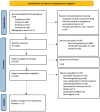Health Education in Mass Gatherings: A Scoping Review to Guide Public Health Preparedness and Practice
- PMID: 40805959
- PMCID: PMC12346179
- DOI: 10.3390/healthcare13151926
Health Education in Mass Gatherings: A Scoping Review to Guide Public Health Preparedness and Practice
Abstract
Objectives: In view of a lack of evidence on the subject, we aimed to perform a scoping review to understand the impact of health education among people attending mass gatherings. Methods: We followed the Preferred Reporting Items for Systematic Reviews and Meta-Analyses extension for Scoping Reviews (PRISMA-ScR) Guidelines. PubMed, EMBASE, Scopus, and Cochrane Library were searched from inception to March 2025 to identify eligible studies. Observational and interventional studies that reported the impact of health education on any health-related outcome among those attending a mass gathering were considered. A narrative synthesis of review results was performed to gather evidence. Recommendations were framed in the context of this evidence. Results: Of the 1731 records, only 17 studies met the inclusion criteria. These included cross-sectional (n = 10), pre-post design (n = 3), quasi-experimental (n = 2), randomized controlled trial (n = 1), and ethnographic (n = 1) studies. These studies involved participants attending hajj, umrah, and basketball events. The current evidence on health education in mass gatherings is highly varied in its objectives, intervention strategy, educational plan, mode of delivery, design, and reported outcomes. Most studies agreed that health education should be initiated by the country of origin and continued throughout the event. It is recommended that this education should be tailored to patient needs based on age, medical condition, and other personal factors, and given in the local language for better acceptability. Such sources can be provided in various forms, either online or offline, as per the participant's convenience. Conclusions: The current evidence on the effectiveness of health education during mass gatherings, particularly in pilgrimage settings, is varied and inconsistent. Participant-tailored health education should be provided, preferably in the local language, through convenient formats.
Keywords: education; hajj; health; mass gathering; prevention.
Conflict of interest statement
The authors declare no conflicts of interest.
Figures
Similar articles
-
Prescription of Controlled Substances: Benefits and Risks.2025 Jul 6. In: StatPearls [Internet]. Treasure Island (FL): StatPearls Publishing; 2025 Jan–. 2025 Jul 6. In: StatPearls [Internet]. Treasure Island (FL): StatPearls Publishing; 2025 Jan–. PMID: 30726003 Free Books & Documents.
-
Health professionals' experience of teamwork education in acute hospital settings: a systematic review of qualitative literature.JBI Database System Rev Implement Rep. 2016 Apr;14(4):96-137. doi: 10.11124/JBISRIR-2016-1843. JBI Database System Rev Implement Rep. 2016. PMID: 27532314
-
Behavioral interventions to reduce risk for sexual transmission of HIV among men who have sex with men.Cochrane Database Syst Rev. 2008 Jul 16;(3):CD001230. doi: 10.1002/14651858.CD001230.pub2. Cochrane Database Syst Rev. 2008. PMID: 18646068
-
Falls prevention interventions for community-dwelling older adults: systematic review and meta-analysis of benefits, harms, and patient values and preferences.Syst Rev. 2024 Nov 26;13(1):289. doi: 10.1186/s13643-024-02681-3. Syst Rev. 2024. PMID: 39593159 Free PMC article.
-
Home treatment for mental health problems: a systematic review.Health Technol Assess. 2001;5(15):1-139. doi: 10.3310/hta5150. Health Technol Assess. 2001. PMID: 11532236
References
-
- World Health Organization . Public Health for Mass Gatherings: Key Considerations. WHO; Geneva, Switzerland: 2015.
-
- Halsey E. CDC Yellow Book 2026: Health Information for International Travel. Oxford University Press; Oxford, UK: 2025.
Publication types
LinkOut - more resources
Full Text Sources
Miscellaneous




